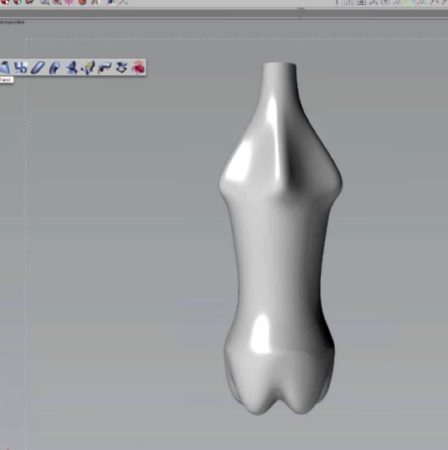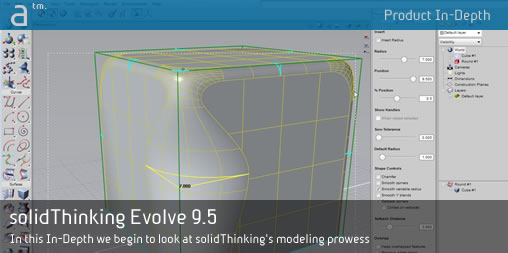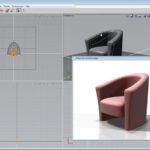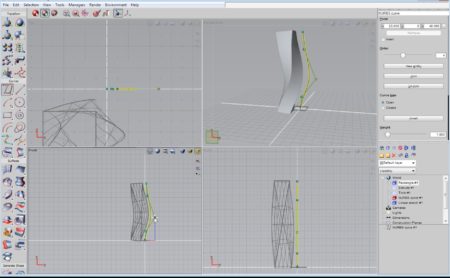Continued from page 1
Visual Qualities and Rendering
solidThinking Evolve 9.5 works in a standard OpenGL view which is shaded. There are options for this as well. There are excellent lighting and shadows implemented in the typical OpenGL working view as can be seen in this bottle example from the Evolve 9.5 webinar.

04 – The standard OpenGL rendered working window in solidThinking supports really nice shadows and lighting allowing the designer to really see and appreciate their creative work.
Adel told me during his demonstration that solidThinking Evolve’s users expect to be able to evaluate their designs, whether automobile, skateboard or armchair with real materials, lighting and put them into environments that might simulate their end use or their point of sale. For instance a showroom for a car or an environment used in a television commercial.

05 – solidThinking Evolve’s extensive Materials Browser helps the designer place high-quality textures and colors on designed objects for photorealistic rendering evaluations.
So Evolve 9.5 features an extensive Materials Browser with hundreds of options including entire predefined sets comprising background, colors and lighting. For our armchair design for example Adel was able to pick a rose fabric quickly from the Materials Browser and render the model with its built-in photographic rendering engine. (see images 05-06)
Global Shape Controls
solidThinking has global shape controls for entire objects or subsets of areas of a model that allow you to twist, perform tapers, warps, shears and other major deformations. And it is some of these tools which suggest some of the potential use for conceptual modeling in architectural environments.
For instance, using solidThinking Evolve 9.5 it is possible to apply global shape controls to basic geometric objects–the kind that typically form the basis of buildings in urban and non-urban environments. We won’t get too deep in the architectural modeling area today in this article (more of that to come in a future article) but Adel quickly showed me how easy it was implement these global shape controls.
For instance, conceptually making a skyscraper of regular rectangular shape, Adel applied a twist function to the entire form. (see image 07 – 08).

07- In this image Adel has setup a basic tower shape. The “scale” transformation is in action at the moment enabling the ability to scale up the width of the tower itself.
In the tower above it can be built up by what is called adding “sections” to the overall tallness or length of the tower form. For readers who are familiar with working with surface modelers in other programs, and in particular subdivision tools, the concept of adding addition sections is clearly familiar. For architectural CAD and modeler readers this may seem odd. To you the tower form has six sides (planes) and each of those consist of four points (vertices) constituting the corners of each plane.
In architectural tools that plane may get punctured or reshaped at its edges or added to with a bump. But subdividing it into sections is less familiar. So what we do when we subdivide the tower above into sections is prepare it for many more possibilities in global and non-global transformations.
For example, using the twist transformation tool we can twist the entire tower from the bottom up as shown in the image above (image 08). But we might want the twist to not begin until part way up the building facade and perhaps not at its top. solidThinking Evolve 9.5 allows you to select the sections you wish the transformation tools to affect and apply the twist only to that portion. Instead of a twist you may want to do a twist and scale making the tower fatter or skinnier in particular sections. Perhaps the tower gets skinnier at the top, the way many towers actually do.
Now here is where the power of the Construction Tree comes in. You can copy this tower multiple (xN) times over within your document or place it into a new file and further iterate options as the entire Construction Tree history comes with the copy. Additionally, when you look back through your construction tree history you can go back and modify primary NURBS curves as well as primary shapes. Perhaps that tower above is switched to a five-sided pentagon plan form or perhaps a circle rather than a rectangular. You do this via the Replace function, which gives the user the ability to swap out a primary or early shape with a new one.
next page: More Power with the Round Tool






Reader Comments
@djnelson75 @architosh Models can be divided with Groups, Layers, or by cataloging parts in the Model Browser.
@Anthony Yes that would be great, or some type of linked block. The problem is, that you get to a point in the design process where you need to know how many bolts you are using, and if you are using the same ones to connect different parts.
@Anthony Yes that would be great, or some type of linked block. The problem is, that you get to a point in the design process where you need to know how many bolts you are using, and if you are using the same ones to connect different parts.
@solidThinking @architosh That is what I like about solidthinking, but at some point you have find out how many bolts you are using.
@solidThinking @architosh That is what I like about solidthinking, but at some point you have find out how many bolts you are using.
@solidThinking @architosh Cataloging parts sounds interesting is that something new? I couldn’t find it in the 8.5 help file(our last trial)
@solidThinking @architosh Cataloging parts sounds interesting is that something new? I couldn’t find it in the 8.5 help file(our last trial)
From http://t.co/7zVtgnx1nw…”Product In-Depth: SolidThinking Evolve 9.5′s Modeling Prowess” http://t.co/zG22jv92Vg
From http://t.co/7zVtgnx1nw…”Product In-Depth: SolidThinking Evolve 9.5′s Modeling Prowess” http://t.co/zG22jv92Vg
@djnelson75,
Well the solidThinking folks are chiming in on this and listening in…perhaps what you seek will come in a future update. 🙂
@djnelson75,
Well the solidThinking folks are chiming in on this and listening in…perhaps what you seek will come in a future update. 🙂
Comments are closed.